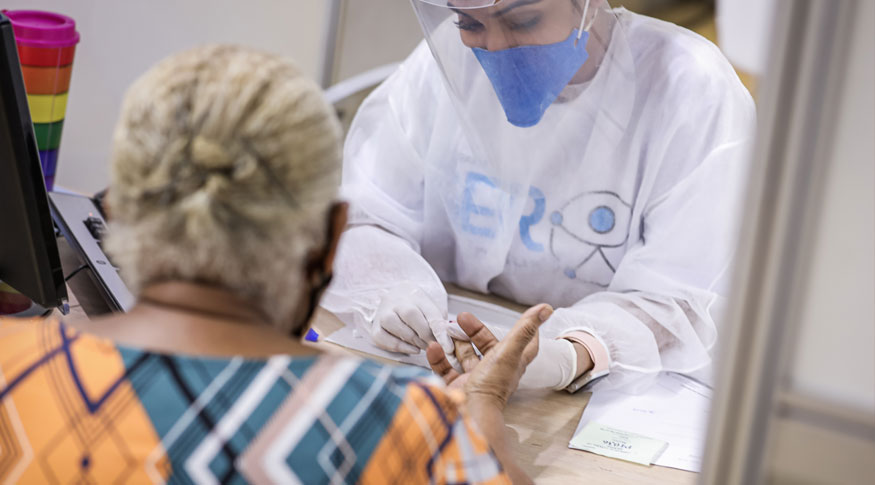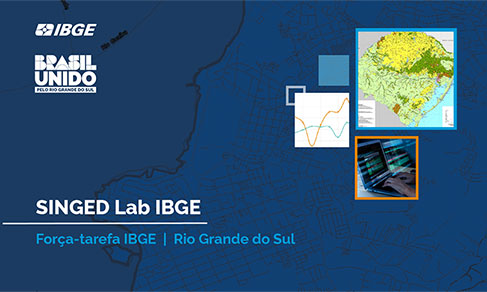PNAD COVID19
Number of people tested for Covid-19 rises to 25.7 million by October
December 01, 2020 09h00 AM | Last Updated: December 02, 2020 04h16 PM
Highlights
- 5.7 million people tested positive for the disease.
- The number of people who have had at least one of the symptoms related to the flu syndrome falls to 7.8 million.
- Unemployment reached 13.8 million people in October.
- 9.7 million people took no restrictive measures against the novel coronavirus
- In October, in less than 900 thousand households, a resident received emergency aid.
- 13.2% of students did not have school activities in October.

The number of people who got tested for Covid-19 rose to 25.7 million in October. Of this total, about 5.7 million tested positive for the disease, which corresponds to 22.4% of the people who tested and 2.7% of the population. The data are from PNAD COVID19, released today (1st) by IBGE. In August, when this information became available, 17.9 million had been tested and 3.9 million had received a positive diagnosis for the novel coronavirus.
“Against September, 3.7 million more people got tested and 897 thousand tested positive”, says the survey coordinator, Maria Lúcia Vieira, detailing that people between 30 to 59 years of age (16.5%) and 20 to 29 years old (14.2%) had more tests than elderly people over 60 years old (10.9%). And that the percentage of tests performed was higher in the group of people who earned more than four minimum wages (24.6%) and who had a higher degree (25.0%).
Among the Federation Units, the Federal District (23.9%) had the highest percentage of people who were tested in October, followed by Piauí (19.1%) and Goiás (18.9%). The lowest percentages were registered in Pernambuco (7.9%), Acre (7.9%) and Minas Gerais (9.3%).
The most performed tests were the rapid test by a finger prick (11.4 million) and the SWAB, a procedure in which the material is collected with a cotton swab in the patient's mouth and/or nose (10.7 million) . Another 7.4 million were tested with blood drawn from the arm vein.
The survey also pointed to a drop in the contingent of those who reported having some flu-like symptoms. In October, 7.8 million people claimed to have at least one of the symptoms covered by the survey, including cough, fever and breathing difficulty. This number represents 3.7% of the Brazilian population. In May, when the survey was started, 24 million, or 11.4% of Brazilians, had at least one of the symptoms.
9.7 million people do not adopt social distancing
In October, people's relaxation regarding social distancing continued to grow. The number of people who did not take any restrictive measures to avoid contamination by the novel coronavirus increased 3.3 million in one month, reaching 9.7 million people, which is equivalent to 4.6% of the 211.5 million residents in the country.
Likewise, the group of people who were strictly isolated reduced to 26.3 million, down 8.2 million compared to September.
Most of the population (93.8 million) claimed to have reduced contact with other people, but continued to leave home or to receive visits, 9.7 million more compared to September. Those who stayed at home and only left in case of need totaled 80.7 million. That number dropped by 4.6 million from one month to the next
Unemployment reaches 13.8 million people
In October, the unemployment rate, measured by PNAD COVID19, reached 14.1%, the highest level in the time series of the survey, which started in May. This corresponds to 13.8 million people without a job in the country, a change of 0.1 percentage points in comparison with September (14.0%).
"With the return of activities around the country, more people are, month after month, putting pressure on the job market in search of an occupation," said Ms. Vieira.
In October, there was an increase in the workforce, totaling 97.9 million people, due to a reduction in the population out of the workforce (72.7 million). The employed population rose to 84.1 million. This can be seen in the increase in formal jobs (which totaled 35.1 million) and also in informality, which totaled 29.0 million people. The informality rate increased to 34.5% in October. In the previous month it was 34.2%.
"Despite the reduction of the population outside the workforce, there is still a considerable contingent of people who did not seek work due to the pandemic or due to a lack of opportunities in their surroundings (14.5 million)", added the survey coordinator.
Labor market data also shows that of the 84.1 million employed persons, 94.4% were not away from work. Of these, 7.6 million were working from home, a reduction compared to the previous month (8.1 million).
In nearly 29 million households, a resident received emergency aid
PNAD COVID19 also informs that the percentage of households where at least one resident received some aid to face the pandemic was 42.2%. In September, it had been 43.6%. About 29 million households benefitted from it in October compared to 29.9 million in September. The average benefit received by the population was R$ 688 per household.
"The percentage of households where a resident received emergency cash aid has been decreasing for three months," says Ms. Vieira, detailing that the regions that have more households with people receiving assistance are still the North (58.4%) and Northeast (56.9%). “This percentage was stable in all major regions. Among states,
Amapá (68.6%) was the one with the highest proportion, followed by Maranhão (61.4%) and Pará (62.2%)”, says the researcher.
Among the types of aid covered by the research are emergency assistance, aimed at informal workers, individual microentrepreneurs (MEI), self-employed and unemployed, and the complementation of the Federal Government by means of the Emergency Program for the Maintenance of Employment and Income.
13.2% of students did not have school activities in October
The survey also shows that, in October, of the 46.4 million students who were enrolled in schools and universities, 6.1 million (13.2%) had no school activity. This number, however, is lower than that registered in September (6.7 million). The majority, 39.3 million (84.7%), had some school assignment. The rest were on vacation (2.1%).
Of the total number of students with school activities, only 25.2 million (64.2%) had assignments to do during five days of the week. Another 892 thousand students (2.3%) only had activities once a week.




















